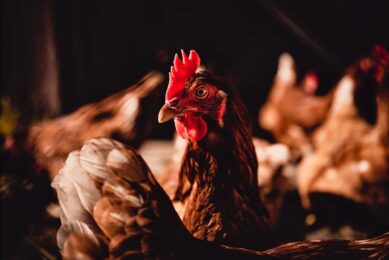Overcoming hurdles for AI vaccination

The poultry industry must take into serious consideration that avian influenza outbreaks may become the new reality instead of a sporadic incident. In order to be able to vaccinate birds, technical, practical and political barriers must be lowered.
It is now summer in Europe; the weather is sunny and (fairly) warm – not the type of weather that suits avian influenza (AI) viruses. The coming months will reveal whether or not this is sufficient to make the virus die out completely. This was the case in previous seasons when high pathogen avian flu circulated among wild birds in Europe. But the current situation is unique: this is the first time the virus spread on such a massive scale among wild birds. Professor Arjan Stegeman, chairman of the expert group Animal Diseases, presents two possible scenarios for the coming period. In the best-case scenario the virus dies, as warm and sunny weather decreases the chances of virus-survival outside a host. In the unfavourable scenario the high pathogen AI virus continues to circulate among wild birds in Europe. In the past months the virus was found in live wild birds, which indicates that at least some strains survive.
Vaccination in sight
There is also a scenario that is considered a serious threat by several experts: Europe could be shaken more frequently by highly pathogen AI viruses brought by wild birds from Asia. The question arises ever more whether or not vaccinating poultry against the virus is one of the possibilities. “I think it will take a few more years, but fundamentally it is feasible,” says Prof Stegeman. “It certainly has perspective for the longer term.” He points out the effects of vaccination, are often smaller in the field than under laboratory conditions. “However, this indicates that it is possible in theory.” Barriers that must be lowered: developing an affordable vaccine that is demonstrably effective in the field, which does not only fight the clinical symptoms but also the spread of the virus, and can be administered in mass and break through trade barriers. These are big hurdles, but many positive developments are taking place.
Initiation discussion on timely AI vaccination
Can vaccinating contribute to the fight against AI? Both in the Netherlands and abroad, attention is devoted to this matter, as the situation with the AI virus and the technical possibilities of vaccination are changing. In the Netherlands, Poultry practice de Achterhoek put the topic firmly on the agenda again last month. At the end of March Poultry practice de Achterhoek organised the symposium ‘Avian Influenza in the future: to V or not to V’, in order to stimulate the discussion on AI.
Many questions about the topic emerged from the field, PPDA poultry veterinarian explains the reason for organising the event. To be able to answer these questions one needs to know the ins and outs, hence the informative afternoon, which was mainly aimed at stakeholders and interest groups from the Netherlands and abroad. “It is too soon to answer yes or no to the question whether we should vaccinate or not, we realised that. But it is good that information about the matter is shared,” says veterinarian Marcel Boereboom.
“I think that, although I do not have a monopoly on wisdom, under certain circumstances vaccination can make a substantial contribution to mitigate the risks of avian influenza, in the medium term. This will take at least three to five years. But we should think this through now, not during a new crisis.” The poultry practice also asked whether the non-vaccination policy of the EU and the increasingly endemic nature of AI still match. A lot is happening on the development side of vaccines. Attention for (European) legislation is necessary in order to keep up with practice. For instance to make it possible a vaccine for every new AI sub type must go through an entire registration process.
Effective vaccine
Developing a vaccine that is effective in the field against quickly changing AI viruses is not simple. Up until now vaccines turn out to work well under laboratory conditions, but field conditions have proven to be more difficult. AI viruses mutate quickly and they mutate a lot. A vaccine that is effective against a particular virus can be completely ineffective several months later, because the field virus has changed so much. An effective vaccine against AI must have a wide-ranging effect, as the virus mutates quickly. H5, H7 and H9 viruses are a threat to human health. This makes them the most important types to vaccinate against. In practice there are several vaccines that aim for the H5 strain in particular, with varying degrees of success.

Mass application
Applying the vaccine is another hurdle. As it is possible for AI to mutate into a highly pathogen virus, live attenuated virus vaccines are not an option. Administering the vaccine to birds manually, similar to what was done in some Asian countries, is not workable for houses with tens of thousands chickens, plus it would be too costly. Steps are being taken on this. A Dutch consortium of scientists is working on mass application of a controlled AI vaccine via powder that enters the airways. Veterinarian Wil Landman of the Veterinary Health Service indicated however that big technical challenges must be faced in order to make this technique affordable and ready for practical use.
New vaccine technique
Vector vaccines are a technique considered to be promising for the longer term. Producer Ceva developed a vector vaccine against the H5 strain of AI. It is effective against all H5 sub types that were tested thus far, says innovation director Yannick Gardin of Ceva at a recently held symposium in the Netherlands (also read: ‘Initiating discussion on timely vaccination’). It can be administered preventively at the hatchery, turns out to offer protection against a broad spectrum of different H5 viruses and significantly reduces the excretion of the virus. Mr Gardin thinks Southeast Asia is a logical place to start. “This is the place where the disease needs to be controlled first. It is the epicentre of avian influenza.” Many new AI viruses originate from this region. Mr Gardin: “In Europe it would make sense to start vaccinating commercially kept water birds, chickens that are kept outdoors, turkeys and laying hens.”

Countering the spread of the virus
A (preventive) vaccine, fighting transmission, is particularly important for intensive poultry farming regions in Europe, emphasised the Dutch CVO Christianne Bruschke during the symposium. We need to gather more knowledge about this. In Europe it is always the aim to eradicate the virus, and for this it is essential that a vaccine counters the spread of the virus. The great fear is that a vaccine protects against the clinical symptoms of the virus, while the virus has the opportunity to spread unnoticed. “When vaccinating is possible, the will is there,” Ms Bruschke said. “First it must be possible.” According to her legislation is the last hurdle to overcome. Currently the European Union only allows emergency vaccination (with a plan). Much more important is that the technical barriers need to be lowered first: a vaccine that demonstrably decreases the spread of the virus. In vaccinating countries the virus often becomes endemic, making it more important to fully reduce the effects and counteract disease symptoms.
Trade barriers
In addition to the complex situation of developing and using an effective vaccine, the trade restrictions countries impose from the moment of vaccination on, are by far the biggest obstacle for vaccination. Many countries don’t want to accept vaccinated animals and/or products of vaccinated animals. Addressing this is necessary before vaccinating on a large scale is even thinkable. Especially for a country like the Netherlands, that depends on export. This requires a discussion on a global level with politics and business. Avian influenza is already used, by some countries, to impose all sorts of restrictions for the import of products that do not always comply with the rules of the World Organization for Animal Health (OIE). The discovery of AI among wild birds should not be grounds for imposing trade barriers. In practice however, this has been the case. The French breeding organisation Grimaud makes a stand for a broad-based signal from the field to make vaccinating possible (also read: Grimaud makes a stand for vaccination) in order to get this stumbling block out of the way.
Grimaud makes a stand for vaccination
Frederic Grimaud, owner and director of Groupe Grimaud, the France-based breeding group, established organisations such as Hubbard (broilers), Novogen (laying hens) and Grimaud Frères (ducks), sent two open letters into the world at the beginning of the year. He recently found time to elaborate on this to Pluimveehouderij editor in chief and Poultry World editor Fabian Brockötter.
He makes a stand for allowing vaccination against AI, especially birds with outdoor access. “We must stop thinking in impossibilities and start finding possibilities. It is of the utmost importance that a widely sustained clear signal is sent to all parts of the world,” says Grimaud who anticipates this. For Grimaud one thing is clear; the existing approach on AI outbreaks is no longer appropriate for current times. “We note and slaughter, this so called ‘stamping out’ procedure has turned out to be an ineffective approach in ‘eliminating’ the virus.
However, how can we eliminate a virus that is all around us in the wild bird population? We must think differently!” The core of this different way of thinking is protecting poultry. “It starts with good hygiene that remains the most important factor. But an essential element of protecting is vaccinating, poultry with outdoor access.” Grimaud realises that a vaccine that is 100% effective does not exist. “This counts for several vaccines. We don’t have to wait for a vaccine which is theoretically perfect. We want to protect our animals against mortality and clinical symptoms and mitigate virus excretion by means of good coverage in the flock. And these vaccines are already on the market.”
Zoonosis
The threat of an AI virus that is much more contagious for humans than is the case with the virus currently going around Europe, may force a breakthrough in the vaccination issue in the coming years. Or may accelerate it. This H5H8 virus had a limited zoonotic potential. In Southeast Asia however, there are AI viruses that are much more zoonotic, and can be easily transmitted between animal and human. The H7N9 virus created hundreds of casualties in China this winter. There is also concern that the H5N6 virus, which infected humans in China and is spreading through Asia, may be the next virus to enter Europe. Ms Bruschke (CVO) endorses the fact that the dynamics and approach will change with the introduction of a more zoonotic virus, starting with the involvement of the Ministry of Health. Ms Bruschke: “The introduction of a more zoonotic virus strain will definitely lead to a different perspective.”
Join 31,000+ subscribers
Subscribe to our newsletter to stay updated about all the need-to-know content in the poultry sector, three times a week. Beheer
Beheer








 WP Admin
WP Admin  Bewerk bericht
Bewerk bericht